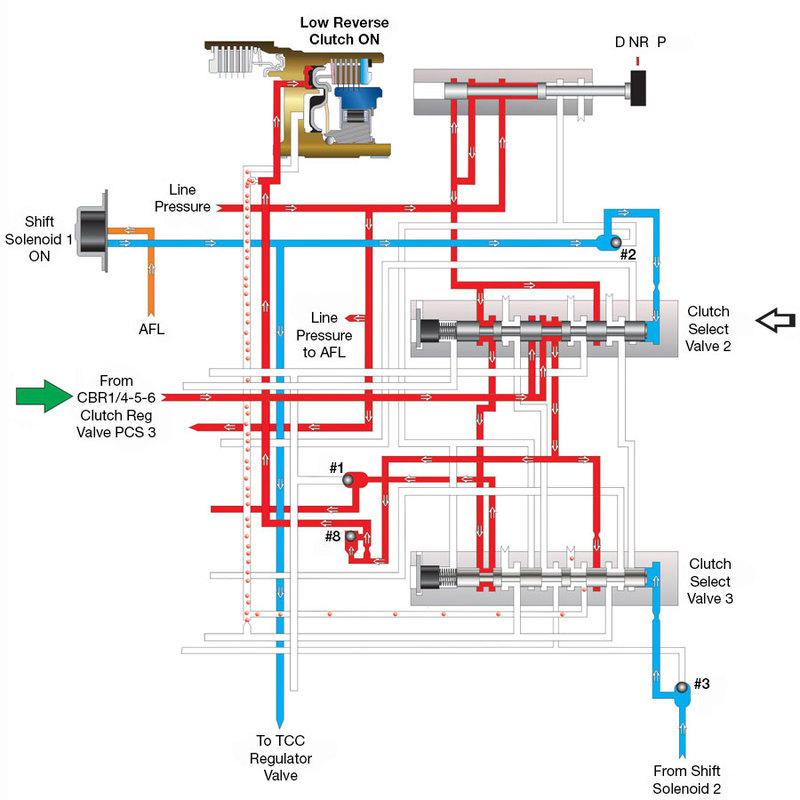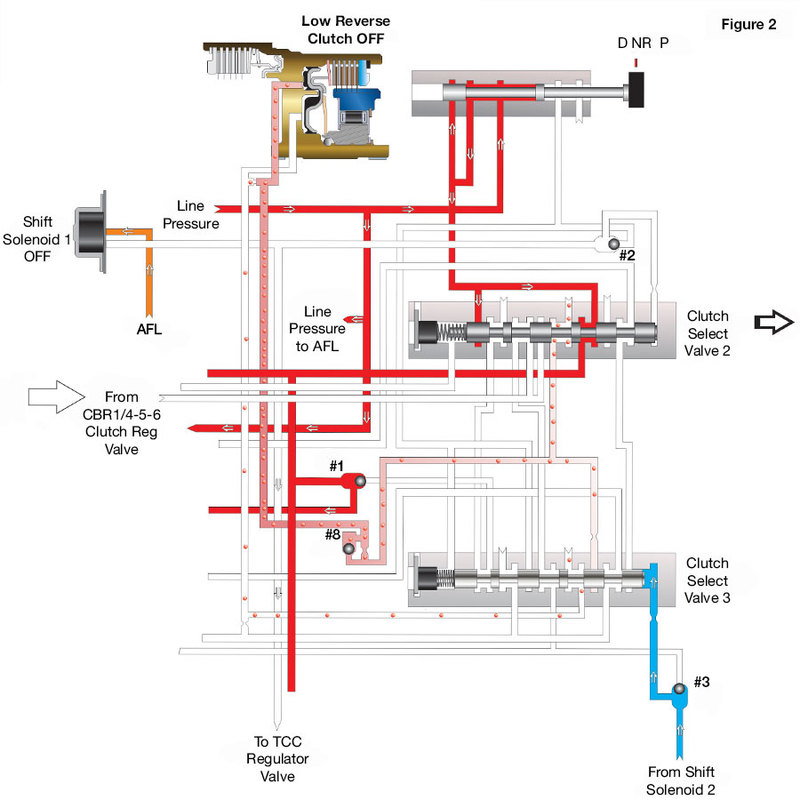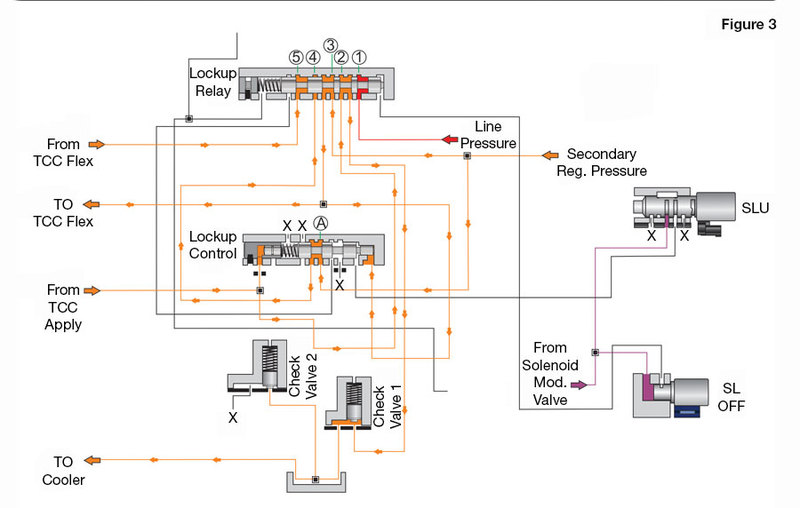January 28, 2019
液压基础技术第一部分:主压力调节器阀门线
Zachary Richardson.
ReadPart I,第二部分,第二部分I,第四部分,第五部分,第五部分I,第七部分,第七部分I和部分IX.of the Hydraulics Fundamentals series.
换档阀从第一天开始围绕自动变速器世界。这些类型的阀门几乎是将线路或离合器压力连接到离合器的栅极保持器施加和/或离合器排气路。回到当天,这些阀门由调速器电路控制,这些阀门将根据车辆在道路上移动的速度打开和关闭换档阀。在当今的变速箱中,换档阀通常由由离合器压力控制螺线管控制的开/关螺线管和/或离合器压力控制。
Figure 1shows an example of typical shift valve function in today’s transmissions. The diagram shows the 6L80 engagement process into Drive 1st Gear from the Park position. Shift solenoid 1 — which is an ON/OFF solenoid — is turned ON, which strokes clutch select valve 2 to the left. This connects CBR1 pressure from pressure control solenoid 3 through clutch select valve 2 — which is functioning as a shift valve — to the low Reverse apply circuit. This connection provides a backup for the low sprag by the low Reverse clutch during launch in 1st Gear.
| Figure 1 – 2014-Later 6L80/90 1st Gear Engine Braking |
|---|
 |
| 当选择器被放置到驱动器从公园/中性,第一齿轮被命令和电磁铁1被通电以提供发动机制动。离合器选择阀2打开,将CBR1 / 4-5-6离合器调节器压力连接到低反向施加通道。 |
Figure 2shows shift solenoid 1 turning OFF — this happens when vehicle speed is increased to a little less than 10 mph. When shift solenoid 1 is turned OFF, notice that clutch select valve 2 is moved back to the right by spring pressure. This provides an exhaust path to the low Reverse clutch and pressure from clutch pressure control solenoid 3 is decreased. So, in conclusion, shift valves of today are still the same — and have the same type of function — as earlier designs. In this instance, you can see that vehicle speed is a factor for low Reverse application in 1stGear. The difference is that transmissions of today get vehicle speed information through electronic speed sensors, not through hydraulic governor pressure.
| 图2 - 2014-后510/90第1档 |
|---|
 |
| 随着车辆速度的增加,TeHCM监控信息以确定何时转动螺线管1螺线管和激励CBR1 / 4-5-6螺线管,以阻挡离合器选择阀2.该动作允许离合器选择阀2移动到右侧,连接低逆转通向排气。 |
继电器阀具有换档阀门非常相似的功能。“继电器”一词意味着接受和传递,有点像老中继比赛巴吞,在高中时的一天又回来了。Figure 3shows a representation of the U760 transmission lockup relay valve in TCC OFF mode. When in this mode, the lockup relay valve receives line pressure to connection point number 1, which is blocked. Secondary regulator pressure is fed to connection point 3. The relay valve passes it along to the TCC release circuit to keep the torque converter clutch from applying and on to connection point A in the lockup control valve, which passes on this pressure back up to connection point 4 of the lockup relay valve, where it is blocked. Connection point 5 receives pressure from the TCC flex apply circuit, which is blocked by the valve. The TCC release circuit connects to the TCC apply circuit through the torque converter and is fed to connection point number 2, where it is sent off to the cooler.
| 图3 - TCC OFF |
|---|
 |
Figure 4shows these valves when TCC is fully ON. The SL solenoid is turned ON by the powertrain control module, and the lockup relay valve strokes to the left. This action connects secondary regulator pressure from connection point 3 to the TCC apply circuit at connection point 2, which feeds apply pressure to the torque converter clutch. At the same time, TCC release pressure is connected to an exhaust path at connection point 4 at the lockup relay valve and is exhausted at connection point B at the lockup control valve, when the SLU solenoid strokes it to the left at high duty cycle. Connection point 1 at the lockup relay valve then connects the cooler circuit to line pressure to help cool the transmission.
| Figure 4 – TCC Fully ON |
|---|
 |
In conclusion, shift valves and relay valves share a lot of the same duties. Hopefully this information will help when diagnosing a shift or relay valve-related problem so you don’t drop the baton.
吉姆拨打is a Sonnax technical specialist and a member of the SonnaxTASC Forcegr(技术汽车专业委员会)oup of recognized industry technical specialists, transmission rebuilders and Sonnax Transmission Company technicians.
January 28, 2019
Zachary Richardson.
2019年2月26日
Maura Stafford
March 26, 2019
吉姆拨打
2019年5月03日
鲍勃沃纳克
3月3日,2020年3月
吉姆拨打
2020年3月26日
John Varvayanis
April 20, 2020
June 08, 2020
不vember 20, 2020
While Sonnax makes every effort to ensure the accuracy of technical articles at time of publication, we assume no liability for inaccuracies or for information which may become outdated or obsolete over time.